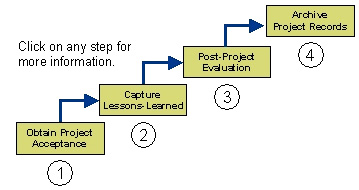
The last major phase of a project's life cycle is the Close-out. Closing a project should be a fairly routine process. This is because you've documented everything you need along the way, haven't you?
The key elements of project close-out are:
- Accepting the project's products indicated by user sign-off
- Conducting a final lessons-learned session
- Completing a post project evaluation report
- Completing and archiving project records

Policy and Standards
All projects should:
- Use a Standard Project Process, as-is or as-tailored to meet project-specific requirements,
- Obtain approval for any project-specific tailoring of a Standard Project Process,
- Document any project-specific tailoring of a Standard Project Process,
- Perform project acitivities according to the project's Defined Process,
- Collect and store appropriate project examples and measurement data for future use,
- Use and maintain a documented and approved project development plan as the basis for tracking actual results and performance of the project,
- Keep the Project Manager informed of the project's status and issues,
- Take corrective actions, such as adjusting performance or adjusting the plans, when the project plan is not being achieved,
- Manage the corrective actions to closure,
- Make changes to the project commitments with the involvement and agreement of the affected groups, such as engineering, estimating, systems integration, testing, quality assurance, configuration management, contract management, and documentation support, and
- Ensure that senior management reviews all commitment changes and new commitments made to individuals and groups external to the organization.s made to individuals and groups external to the organization.

Responsibilities
The responsibilities for Project Close-Out are summarized below:
- Project Managers are responsible for obtaining formal project acceptance from the project sponsor and/or stakeholders
- Project Managers are responsible for capturing and documenting lessons learned throughout the life of the project
- Project Managers are responsible for preparing and distributing the post project evaluation report
- Project Managers are responsible for ensuring the completion and archiving of project records.

To order a full set of the Project Templates and Checklists
click here
Buy Now